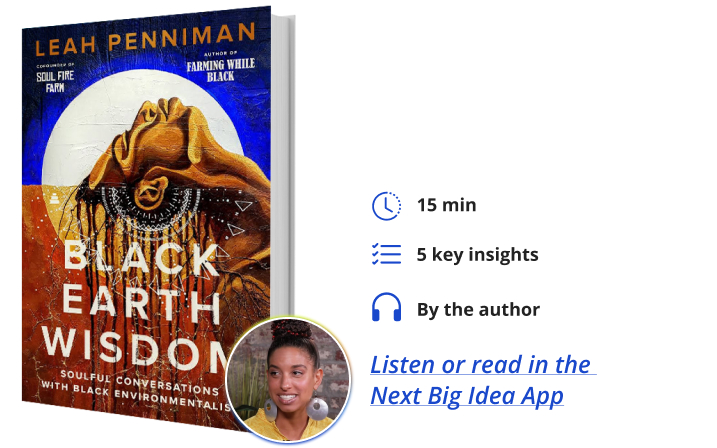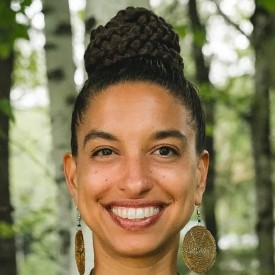Leah Penniman is a Black Kreyol farmer/peyizan, mother, soil nerd, author, food justice activist, and cofounder of Soul Fire Farm in Grafton, New York. She has been farming for more than twenty-five years, holds an MA in Science Education and a BA in Environmental Science and International Development from Clark University, and is a member of clergy in West African Indigenous Orisa tradition. Her first book, Farming While Black: Soul Fire Farm’s Practical Guide to Liberation on the Land, is a love song for the land and her people.
Below, Leah shares 5 key insights from her new book, Black Earth Wisdom: Soulful Conversations with Black Environmentalists. Listen to the audio version—read by Leah herself—in the Next Big Idea App.

1. For Black environmentalists, science and spirituality are intertwined.
Dr. George Washington Carver was a pioneer in regenerative agriculture as one of the first agricultural scientists in the United States to advocate for the use of leguminous cover crops, nutrient-rich mulching, and diversified horticulture. He had thousands of patents and was called “one of the ten greatest scientists of all time” by Albert Einstein.
When asked where he got ideas for his ecological innovations, he said that he awoke in the predawn hours and went to the forest to talk to plants. This is where he received instructions for his work. In 1887, Dr. Carver said, “I love to think of nature as unlimited broadcasting stations, through which God speaks to us every day, every hour.” As Dr. Carver explained, “How do I talk to a little flower? Through it I talk to the Infinite. And what is the Infinite? It is that silent, small force… that still small voice.”
This practice of earth-listening is part of our cultural heritage as Black people. Like Dr. Carver, Black environmentalists like Dr. Wangari Maathi, founder of the Green Belt Movement; Harriet Tubman, herbalist and freedom fighter; John Edmonstone, ornithologist; Dr. Charles Henry Turner, zoologist; Hattie Carthan, tree planter; Hazel Johnson, community organizer; and others, had a direct spiritual connection that inspired their work.
2. The earth speaks in many languages.
One of the great challenges of our time is that humanity, by and large, has forgotten how to listen to the earth. We are no longer literate in the languages of the earth, and we no longer understand our kinship bonds with nature.
“Society has come to rely on secondary and tertiary sources, farther and farther away from the sky, to get information.”
Audrey Peterman, Jamaican elder and lover of wild spaces, put this well when she explained that there was once a time when most people could read the night sky. We could tell directionality, seasons, weather, story, and the calendar by reading the stars and clouds. The sky was our primary source. Society has come to rely on secondary and tertiary sources, farther and farther away from the sky, to get information; a dangerous and distorted game of telephone yielding scrambled messages.
There was a time when we knew to plant corn when the oak leaves were the size of squirrel’s ears, says Leni Sorensen, because the soil was finally thawed and warm. The languages of the earth are many: ice cores, the pH of the ocean, bird song, gravity, tree rings, animal tracks… If I were to tell you I had lived in a neighborhood my whole life and didn’t learn the names of the people next door, you might have some judgments on my character. And yet, here we are in a neighborhood of trees, insects, and amphibians that many of us cannot call by name.
What we do not know, we also cannot love, and our kinship bonds weaken.
3. Some have forgotten that we are kin with the natural world.
As a young adult, I spent months studying agriculture in Ghana, West Africa, one of my ancestral homelands. My mentors were the Queen Mothers of Manya Krobo, guardians of history, culture, and land. They asked me one day, “Is it true that in the USA, most farmers put a seed in the ground and they don’t pray, or dance, or sing, or pour libations, or even say thank you to the seed and they expect it to grow and feed them?” When I ashamedly admitted to this, they said, “Well, no wonder you are all sick! You think the earth is a thing and not a living being.”
“Embedded in the theory of the supremacy of white people is the theory of human supremacy over nature.”
Non-kin thinking is what leads to both racialized oppression and earth ravaging. It is the severing of family and the relegating of others to “non-person” that make possible the enactment of violence and oppression. Embedded in the theory of the supremacy of white people is the theory of human supremacy over nature. Non-kin thinking is a uniquely Western invention, as described in 1846 by Senator Thomas Hart Benton, who asserted, “It would seem that the White race alone received the divine command, to subdue and replenish the earth: for it is the only race that has obeyed it – the only race that hunts out new and distant lands, and even a New World, to subdue and replenish…”
The consequences of earth illiteracy and non-kin thinking are utter devastation and deep trouble.
4. Nature is cooperative and generous.
Nature centers cooperation over competition more often than we are taught to believe. Mutualistic interactions are vital for terrestrial ecosystem function as about 80 percent of land plant species rely on mycorrhizal relationships with fungi to provide them with inorganic compounds and trace elements. The estimate of tropical rainforest plants that utilize seed dispersal mutualisms with animals ranges numbers at 70–93.5 percent. Mutualism has also been linked to major evolutionary events, such as the evolution of the eukaryotic cell (symbiogenesis) or the colonization of land by plants in association with mycorrhizal fungi.
Creatures help each other. For example, vampire bats regurgitate their own blood to prevent other bats from starving. Ground squirrels, velvet monkeys, and prairie dogs cry out to warn their peers of predators, even though drawing attention to themselves increases their chance of being eaten. Ants and bees give their lives to protect their colonies. Birds migrate in a V-formation where each bird, except the first, benefits from the upwash from the wingtip vertices of the bird ahead, reducing their average energy output by 12-20 percent as compared to flying alone.
“Creatures help each other.”
Lichens are a symbiotic collaboration between algae and fungi, where the fungi support the algae’s survival in extreme conditions in exchange for sugar. Nitrogen fixation is only possible through an inter-kingdom mutualism between leguminous plants and rhizobial bacteria. Insect pollination, which we depend upon for 80 percent of human food crops, relies upon a relationship between flowering plants and insects. Humans would be unable to digest food without the 1013 to 1014 microbes living in each of our guts, which match or outnumber the human cells in our body.
Scientists are now arguing that the very concept of the individual organism needs rethinking, and that multicellular organisms and their symbiotic microbes may be regarded as cohesive units acted on by natural selection.
5. Nature does not hate.
In an 1873 speech, Frederick Douglass remarked, “The grand old earth has no prejudice against race, color, or previous condition of servitude, but flings open her ample breast to all who come to her for succor or relief.”
This remains true. In the face of racialized brutality, health crisis, or collective pain, Black people continue to lay down our burdens by the riverside. Nature has an endless capacity to compost trauma into hope, and receives each of us as her child. Chris Bolden Newsome hears the earth say, “I love you and you are mine.”
Drew Lanham testified, “The land did not hate, only people did. Earth never judged or spat. Not a single cardinal or ovenbird has ever paused in dawnsong declaration to ask the reason for my being.”
I will conclude with a poem by Ross Gay, author of the foreword to Black Earth Wisdom:
A small needful fact
Is that Eric Garner worked
for some time for the Parks and Rec.
Horticultural Department, which means,
perhaps, that with his very large hands,
perhaps, in all likelihood,
he put gently into the earth
some plants which, most likely,
some of them, in all likelihood,
continue to grow, continue
to do what such plants do, like house
and feed small and necessary creatures,
like being pleasant to touch and smell,
like converting sunlight
into food, like making it easier
for us to breathe.
To listen to the audio version read by author Leah Penniman, download the Next Big Idea App today:































